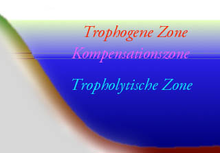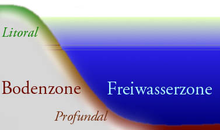Littoral zone
![]()
This article is about the littoral region. For other meanings, see Littoral (disambiguation).
![]()
This article or subsequent section is not sufficiently supported by evidence (e.g., anecdotal evidence). Information without sufficient evidence may be removed in the near future. Please help Wikipedia by researching the information and adding good supporting evidence.
Littoral (from Latin litus "shore", "coast") is a biological term for the shore region of a lake or river as well as the coastal region of the sea. The associated adjective is littoral. The area above the trophic compensation level belonging to the marginal, littoral bottom zone (benthal) of a water body is biologically highly productive and contains a species-rich fauna and flora with a high density of individuals. The inland epilitoral zone, where the influence of the water body is only indirectly effective, does not belong to the actual bottom zone.
The term intertidal zone can be applied to bodies of water that are influenced by tides (low and high tides). The area of a tidal zone that dries out at low tide is called a tidal flat in the geosciences.
Lakefront zoning
The majority of photosynthetic activity takes place in the sunlit littoral. The animals settled in this habitat form spatially delimited organizational groups. In the littoral of a lake, there are three plant zones: Reed zone, floating leaf zone, and diving leaf zone.
- Epilitoral, alder belt, willow scrub zone
Moisture-tolerant plants thrive on the lakeshore, hygrophytes such as mosses, rushes and marsh marigold. Alder swamp forests with willow, downy birch and black alder determine the picture among the plants of the higher floors.
- Supralittoral, splash zone
This strip of shore is not reached by the waves. However, it is soaked by the splash water of the waves breaking on the shore. A rinsing seam can form here.
- Eulittoral, surf zone
Strong mechanical forces prevail in the surf zone, which do not allow larger plants to grow. However, firmly attached, oxygen-loving organisms such as strudel worms (Turbellaria spec. ) and crust-forming cyanobacteria can settle here.
- Infralittoral or sublittoral
This zone is home to larger plants that are adapted to a constantly flooded soil. They have an aerenchyma, an interconnected system of large intercellular spaces, so that the roots can also be supplied with oxygen. This riparian area serves as a spawning and breeding ground for many fish, amphibians, birds, and insects. The infralittoral is divided into different sections.
Below the shore zone, separated by the trophic compensation layer, lies the dark depth region, the profundal.
See also: Lake ecosystem

Structure of a lake - biotic factors

Topographical structure of a lake
Zoning of the sea coast
The zoning designation of the littoral on a seashore depends on the water depth and the presence of tidal influence (tide, tidal).
- Epilitoral
In the vicinity of the coast, in the dune area behind beach walls and dikes, the influence of the sea can still be seen through rising saline groundwater and salt water dust in the air. At most, extreme storm surges reach this area.
- Supralittoral or Supratidal
The splash zone above the high tide line outside the tidal range, which is only briefly covered by water during storm surge events.
- Eulittoral, hydrolittoral, littoral or intertidal
The intertidal zone between the high and low tide lines, characterized by the alternation between low and high tide. Tide pools are found here with rocky substrates. Species-rich mangrove forests also form on tropical coasts.
- Sublittal or Subtidal
The shallow (neritic) shelf region permanently covered by water, below the low-water line to the shelf edge at an average depth of 200 m. Coral reefs also form near the shore, initially as fringing reefs, and on islands also coral atolls.
Search within the encyclopedia